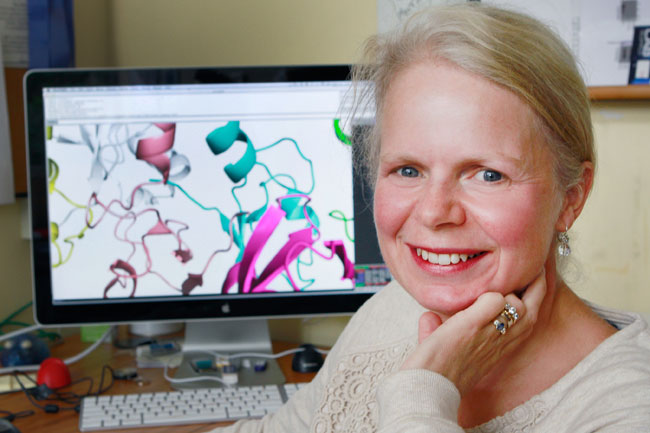 Professor Catherine Day
Professor Catherine Day
University of Otago biochemistry researchers are continuing a fine trans-Tasman history of scientific connections by making use of the Australian Synchrotron in Melbourne in their studies – a roughly football-field sized machine that can create intense beams of light a million times brighter than the sun.
Otago scientist Professor Catherine Day and colleagues are using the awesome power of the Synchrotron's MX beam-lines to probe the innermost secrets of the complex protein signalling mechanisms that regulate inflammation in human cells.
Professor Day says inflammation is supposed to be an acute protective response that keeps our tissues in a steady state and cells in good health. However, when the inflammatory response is not closed off, or the signalling involved otherwise goes awry it can lead to cancers and other diseases.
Using the synchrotron, the researchers have been able to make great strides in their crystallography studies to determine the shape of one of the key proteins in this signalling process. The protein, known as TNF receptor-associated factor 6, or TRAF6 receives a signal from sensors on the outside of a cell that inflammation is required.
TRAF6 then transfers the inflammation signal to other parts of the cell – much like how a relay transfers a baton from start to finish. Dr Day's research has now shown how parts of TRAF6 help it to bind to other TRAF6 proteins, and similar TRAF5 proteins, to pass on that signal. These latest findings are newly published in the leading international journal Nature Communications. Study first author Dr Adam Middleton says revealing the fine detail critical to this research was only possible due to easy access to the synchrotron.
New immunotherapies, which harness the body's own immune mechanisms rather than rely on traditional “carpet-bombing” approaches such as chemotherapy or radiotherapy, have been successful recently in the treatment of cancers such as melanoma and autoimmune diseases such as rheumatoid arthritis.
However, much is still to be learned about the intricate interplay of these mechanisms, Professor Day says.
“Understanding precisely how TRAF proteins cooperate to reliably integrate and transmit inflammatory signals will help researchers to understand exactly how these immunotherapies therapies work, and ultimately improve them,” she says.
“For instance, other research has recently suggested that TRAF6 plays a key role in regulating melanoma invasion and its metastatic spread. Learning more about the exact mechanisms involved opens the way for new or refined targets for therapy for melanoma, and diseases associated with chronic inflammation.”
This research was supported by funding from the Genesis Oncology Trust (NZ) and the Health Research Council of New Zealand.
For more information, contact:
Professor Catherine Day
Department of Biochemistry
University of Otago
Tel: +64 3 479 7864
Email: catherine.day@otago.ac.nz
Publication details:
The activity of TRAF RING homo- and heterodimers is regulated by zinc finger 1
Adam J. Middleton, Rhesa Budhidarmo, Anubrita Das, Jingyi Zhu, Martina Foglizzo, Peter D. Mace & Catherine L. Day
Nature Communications
DOI: 10.1038/s41467-017-01665-3
A list of Otago experts available for media comment is available elsewhere on this website.
Electronic addresses (including email accounts, instant messaging services, or telephone accounts) published on this page are for the sole purpose of contact with the individuals concerned, in their capacity as officers, employees or students of the University of Otago, or their respective organisation. Publication of any such electronic address is not to be taken as consent to receive unsolicited commercial electronic messages by the address holder.
